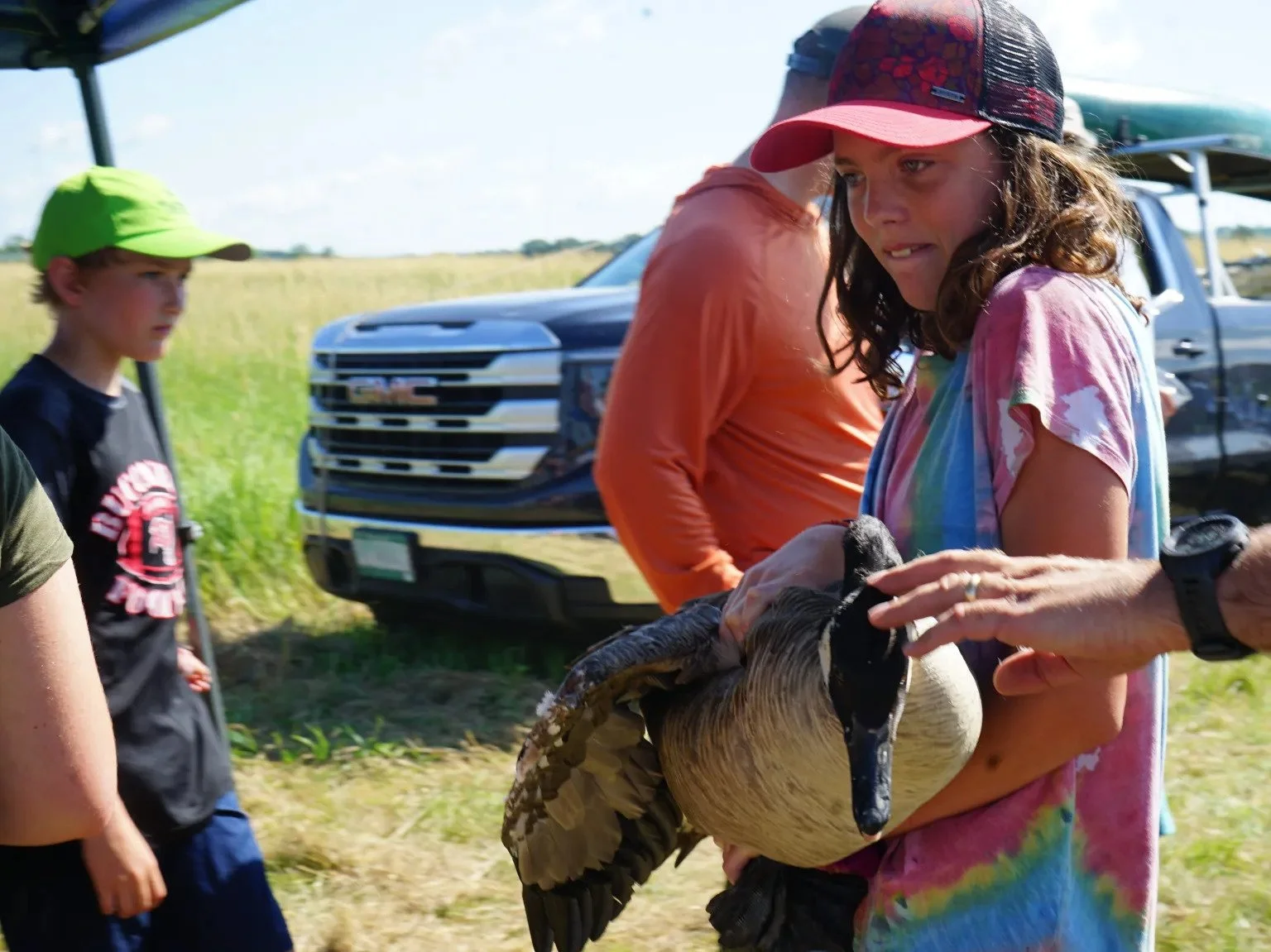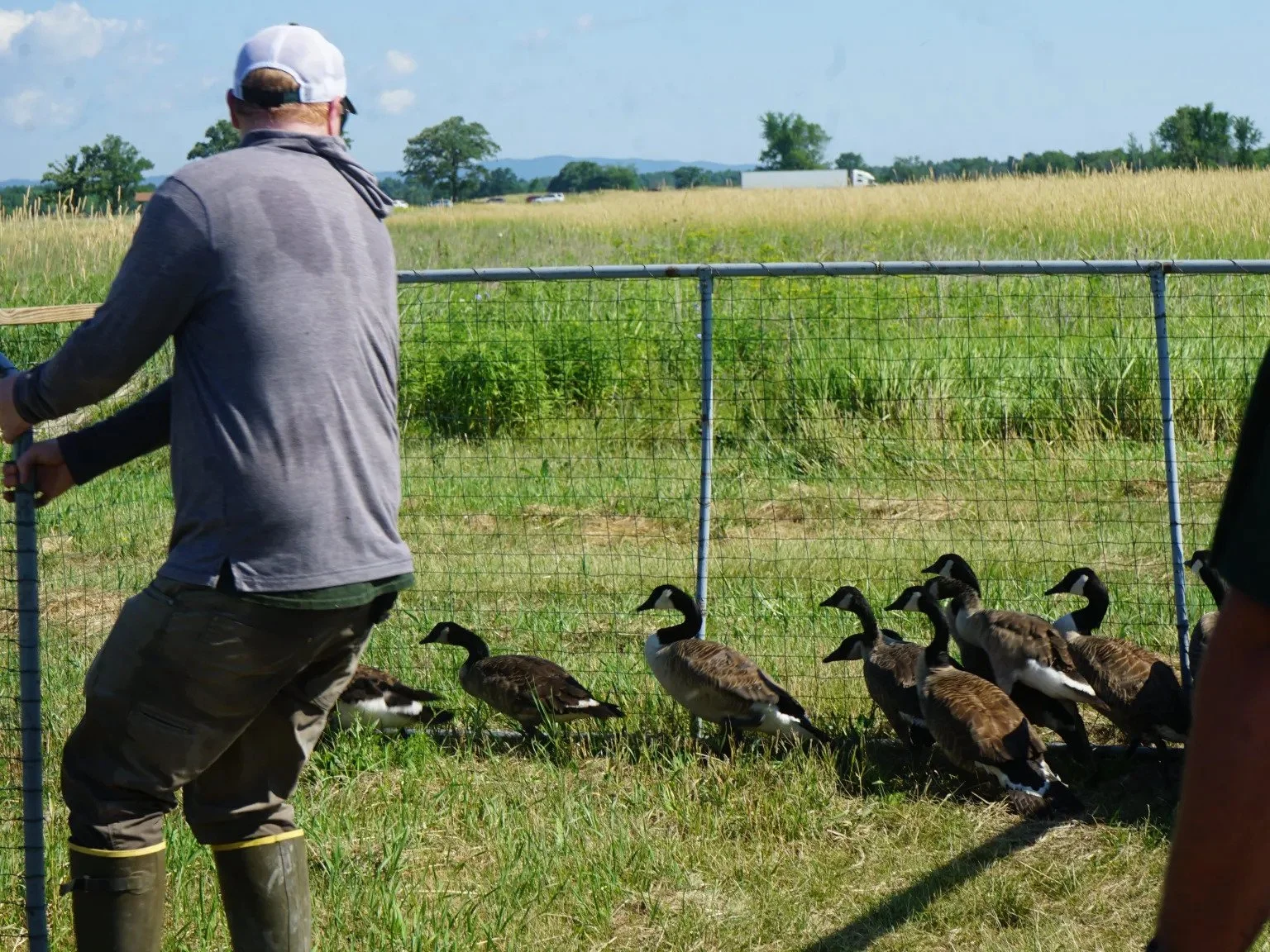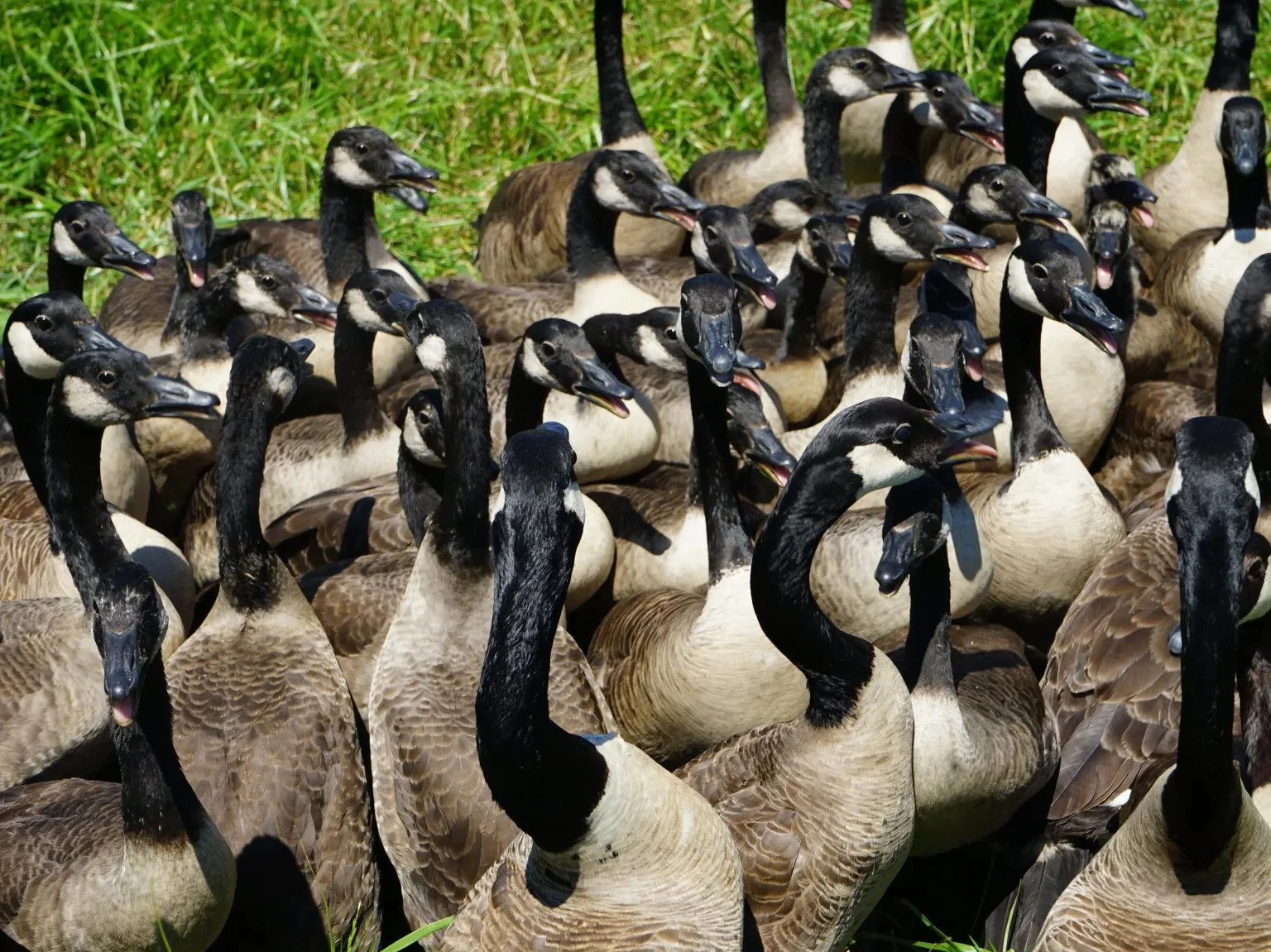The art of herding geese — and why Vermont does it every year at Dead Creek
July 21, 2025 | By Maeve Fairfax | Community News ServiceVolunteers and biologists, including Wildlife Management Program Manager David Sausville, look at the geese they trapped on July 2. Photo by Maeve Fairfax
ADDISON — A circle of volunteers appeared from the brush beside a field and slowly converged on a gaggle of Canada geese. They herded them into an enclosure, and the few birds that escaped the roundup were retrieved one by one.
Canada geese molt their flying feathers in the summer, grounding them for a few weeks. That provides a window for state scientists — and volunteers like those at the Dead Creek Wildlife Management Area recently — to keep tabs on the birds.
During the season, the state tries to secure identifier bands on 1% of the nesting population of Canada geese, or 300-400 birds, the minimum experts say they need to estimate the population overall.
State officials have hosted a goose-banding day every year at the wildlife area since the 1960s, said biologist Andrew Bouton, who leads the Department of Fish and Wildlife’s migratory game bird efforts.
Data from the event is used to track the nesting population, sex ratios, how many juveniles survive to adulthood and details on birds killed by hunters, he said.
The volunteers who turned out July 2 for this year’s edition were an eclectic group, wearing everything from head-to-toe camouflage to tie-dyed tank tops and jean shorts.
A volunteer at the Dead Creek Wildlife Management Area on July 2 carrying a Canada goose. Photo by Maeve Fairfax
“I know some of the folks here were hunters,” said David Sausville, who runs wildlife management for the department. “I know a lot of them are families with young kids trying to expose them to it, and then there’s folks that I know that are just straight conservationists, too, that enjoy being out in the land.”
The band is “basically a bracelet,” Bouton said. They aren’t fitted with any electronic trackers, but each has a unique number. Hunters who kill a goose with a band can report the number to a federal database.
Officials can learn a lot about a goose from its number: when it was banded, how old it was then, if it was recaptured and, as Agency of Natural Resources Secretary Julie Moore said, “a little bit of travel history.”
The July 2 banding spanned two sites. The 60 or 70 volunteers split into groups and approached the first of what the biologists called the “goose roundup fields” from all sides. Some geese were on a pond nearby, so volunteers in a canoe flushed them out of the water and into the field. The others, already in position on land, herded them into a pen set up earlier.
The sun was hot and a lot of volunteers left early, so it was a smaller group that approached the second site. Carrying portable fencing, they formed a ring just outside the field and, after encircling the geese and guiding them into the right position, constructed a pen around the birds.
They set up a shade tent, and biologists poured water on the geese to calm and cool them, Bouton said.
The geese proved difficult to handle — later, one even escaped from someone’s hold and sprinted away honking.
After the geese were corralled, volunteers carried them to another tent, where experienced banders recorded the sex of each bird and affixed a metal band to their leg with pliers. After all the birds were banded, they were released into the field.
Wildlife biologist and Dead Creek Visitor Center manager Amy Alfieri clamps a band on a Canada goose. Photo by Maeve Fairfax
The final tally for the day was 73 new birds and 17 recaptured ones, average numbers for the event, Sausville said.
Vermont Fish and Wildlife keeps a close eye on the state’s Canada geese because the population is young — and exists largely because of human intervention. Dead Creek Visitor Center manager Amy Alfieri said the nesting population, including the birds banded at this year’s event, descends from geese in a decades-old program at Dead Creek.
In 1956, the state trapped 44 Canada geese, clipped their wings, then released them into a 70-acre enclosed area around the creek. By 1960, they were nesting. Canada geese have strong homing instincts and usually return to the place they were born to raise young. Now around 300 goslings are born in the Dead Creek area each year.
Once the nesting population was established, more migrating geese started to stop by Dead Creek. Between 2,000 and 5,000 migratory Canada geese come to the area each fall, according to the state.
And it is no accident. “The area was designed as basically a waterfowl management production area,” Sausville said. In the ’50s, dams were built with mechanisms to control water levels and used to create open water and wetland habitats, he said.
At the time, a lot of Vermont’s wildlife was threatened, and there was a push to re-forest the land and bring birds — particularly game species — back in.
Much of the work at Dead Creek was done by World War II veterans, who had developed engineering and construction skills in the military or studied conservation on the GI bill, said Sausville.
Volunteers corralling geese into a pen. Photo by Maeve Fairfax
“This is the original wetland creation story in Vermont,” Moore said.
Water levels in the area are periodically lowered to expose mudflats and allow plants to grow. The areas are flooded again, and the plants provide a food source for waterfowl, said Alfieri.
Some fields in the management area are leased to farmers who grow food like corn and alfalfa, which help attract waterfowl, she said.
The state’s target nesting population of Canada geese is 24-25,000 birds, Sausville said.
That number is based on what the environment can handle but also on what he called Vermont’s “cultural carrying capacity,” or how many geese humans are willing to coexist with.
“I’m sure that the biological carrying capacity is actually higher than that, and the landscape could hold more of them,” he said.
Dead Creek Wildlife Management Area is about 3,000 acres, and 400 of those serve as a refuge, meaning no hunting is allowed and no one can go inside. But there are five hunting blinds in other parts of the area that allow hunting on a limited basis.
Controlled hunting has been allowed in Dead Creek since 1974. Permits are available through a lottery for several days in October and November. Limits for how many geese can be shot per day are announced each year.
A close-up look at the geese caught at the second goose roundup field. Photo by Maeve Fairfax
“We’ve been consistently right around 7,000 waterfowl hunters statewide for many years,” Sausville said.
Doug Smith of Addison, who came to the July 2 event, is one of them. He has been hunting in Vermont since the 1970s, both within and outside of the Dead Creek area. He said he’s been a regular at the event over the years. Many of the state workers there seemed to know him.
“The trouble is, if you hunt the same area quite often, the geese aren’t going to go there anymore,” he said, explaining his strategy of rotating to different hunting spots. “They’re not dumb.”
Part of the state’s continued focus on the Dead Creek area is due to its role within the Lake Champlain flyway, Moore said. That’s a section of the larger Atlantic Flyway, the path most birds take when migrating along the East Coast. Moore said her agency has used money from the Environmental Protection Agency to buy poor farmland and convert it to wetland habitat for migratory birds.
The end goal, she said, is creating a connected block of protected habitat in the Otter Creek watershed, of which Dead Creek is a part.
“Projects that are at the intersection of some of our water quality goals for Lake Champlain and create habitat is this serendipitous win-win,” Moore said.
The University of Vermont’s Community News Service is an internship program that provides Vermont news outlets with reporting, including the Waterbury Roundabout.





